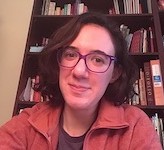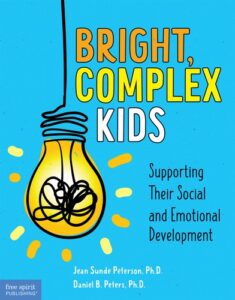Supporting the Growth of Bright, Complex Kids
Bright, Complex Kids: Supporting Their Social and Emotional Development
By Jean Sunde Peterson, Ph.D. and Daniel B. Peters, Ph.D.
(Free Spirit Publishing, 2021 – Learn more)
Reviewed by Amy Estersohn

It’s rare to see a book that includes short chapters, an effective table of contents, and concise summaries that help busy parents and educators get “the gist” of a topic – AND a thorough references section to make emerging experts and researchers happy.
Bright, Complex Kids is one of those books, written by two research-oriented clinical psychologists who work with gifted children and teens.
I’m not gifted, am I?

They observe that there are gifted students in every socioeconomic and cultural context, and that not every student who would benefit from gifted services will be screened for gifted eligibility.
Further complicating these matters is the coincidence of giftedness and learning disabilities (twice-exceptional). For some students, their learning disabilities dominate or mask their strengths, and they would not be identified as gifted through assessments or observations alone.
Common challenges for gifted students
This book mostly focuses on the socio-emotional challenges that gifted students face, with chapter titles like “Achieving and Underachieving,” “Worrying,” “Feeling, Struggling, Hiding,” and “Coping with Adversity.” Each chapter provides a balance of anecdote, reports on gifted student research, and suggestions for classroom, family, and therapeutic interventions.
For example, the chapter dedicated to perfectionism includes activities and discussions that can be modified to fit small group therapy sessions, classrooms, or living rooms. Casual readers will enjoy the ease of finding relevant information and the “Points to Ponder” that end each chapter, while professional readers will be able to follow up on developing research and theoretical models.
Throughout each chapter, a theme of compassionate nonjudgment emerges, particularly around a gifted student’s school performance. If anything, the chapter called “Optimistic about Underachievement” provides evidence that many gifted students will be able to outgrow academic underachievement once socio-emotional support systems are in place.
Important takeaways for parents and educators
It’s a complex world and it’s quite likely many of us teach, work, and lead in communities where gifted students have not been identified or have not received fully appropriate services for a variety of reasons.
Dr. Peterson writes about working in a school that had programming like field trips, lunch discussions, and performances available for achievers and underachievers alike. Many of these completely voluntary, non-credit opportunities were well-attended by underachievers, serving as a reminder that academic acceleration is only one small piece of what can help a gifted student thrive.
This book is recommended for parents, educators, health professionals, school leaders, and community members who are looking for ways to improve access, understanding, support, and resources to all students.
Amy Estersohn is a secondary school teacher and college admissions consultant. Her website is www.leadwithtalents.com.


































